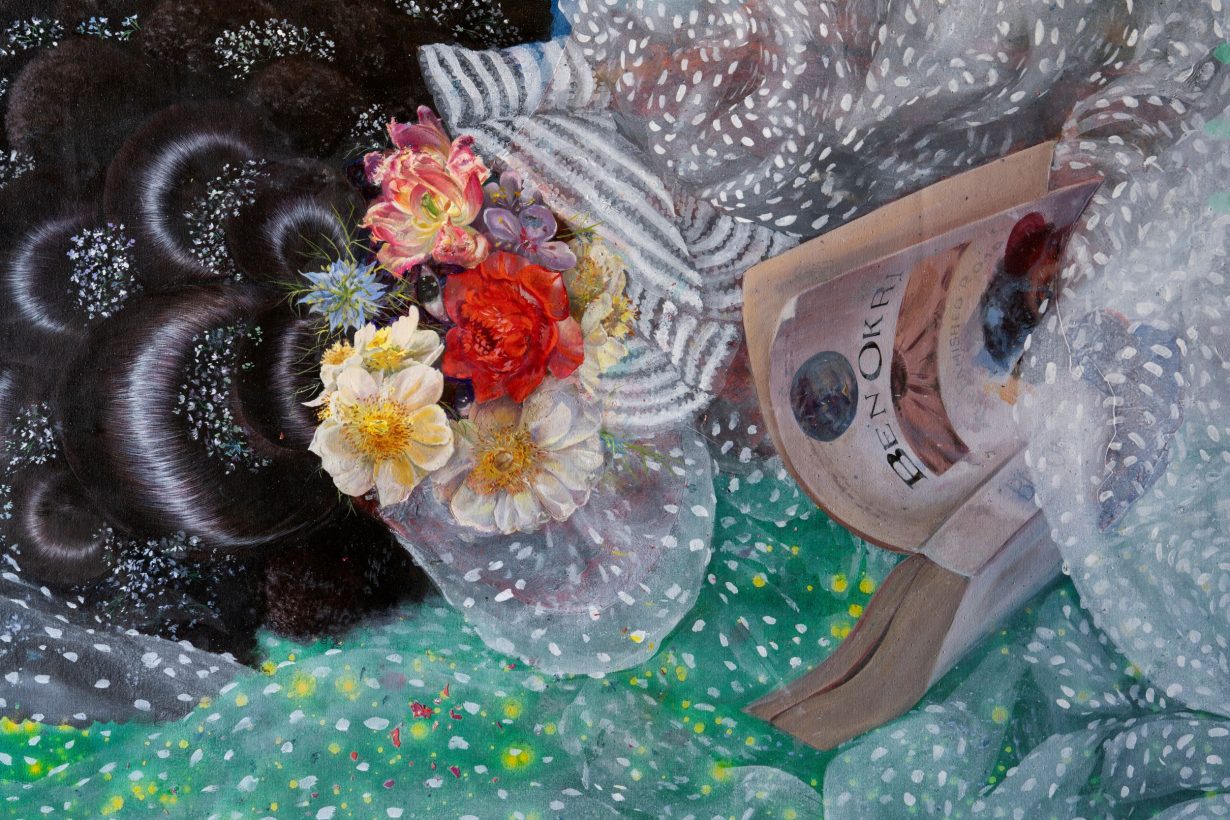Sueño de la Madrugada (A Midnight’s Dream) at South London Gallery casts the Dominican-folkloric creature as a storyteller across time
Firelei Báez’s first solo exhibition in the UK is a transportive synthesis of folklore and ritual, history and memory that weaves plural ways of gathering knowledge and sensing environments, reaching from Vodou symbolism to critical retellings of colonial archives. Báez’s immersive installations and meticulous miniatures converge in her fascination with the ciguapa, a mythical creature found in Dominican folklore. Tricky and wild, these shapeshifters are characterised by flowing manes and backwards-facing feet, their reverse footprints dissembling their tracks.
Inspired by the artist’s memories of growing up on Hispaniola and her knowledge of the Caribbean island’s turbulent histories of enslavement and revolt, Báez’s ciguapas dance between rooms, unruly, untamed and ambiguous in form. Often, they’re only identifiable by their feet, barefoot or in high heels. In the main gallery, two rows of ciguapas – Numinous (the beautiful terror of eternity) (all works 2024) and Joy out of fire (speaking to the space you fill and you keep) – are portrayed as large aluminium silhouettes poured in swirling acrylics and mounted so as to appear as if floating from the walls. They are surrounded by folds of blue tarpaulin draped from the ceiling and cut with eyelike slits. Grouped together as if in a cabaret lineup, the ciguapas’ dancerly legs hover just above the floor. From these legs, their bodies fuse and grow into windswept trees, necks indistinguishable from trunks. The ciguapas seem to inhabit a space between myth, memory and speculation, simultaneously in the past, present and future, and scale is constantly distorted: Báez’s poured paint glistens on the silhouettes’ surfaces, resembling satellite imagery of rivulets and dunes.
Stepping into the main gallery, one enters a dimension at once celestial, vegetal and aquatic. On the floor, Labyrinth (to all the good and pleasures of this world) appears as a body-length Haitian Vodou symbol in LED neon, glowing in a bed of sand like a hot poker. A soundscape blends London traffic with Caribbean cicadas and the lapping of waves. It is immersive, but not entirely: the gallery’s doors remain wide open to the bright bookshop and the street beyond. Rather than transporting viewers to a new realm, Báez invites them into multiple intersecting worlds, real and imagined, a pluriverse that defies any single vantage point or universalising epistemology.

The exhibition continues at the gallery’s nearby Fire Station building with the series A power visible to itself, four wall-size canvases of the artist’s poured-paint technique, an enthralling, kaleidoscopic celebration of colour and form. Here the ciguapas are green feet and reclining bodies that morph into nebulous patterns.
From a second gallery’s walls float two clusters of works made from yellowing found pages. A modest mythology of walls (to think thought but stay away from its chaotic journey) and Amidst the future and the present, time is a memory table include carefully etched plantation scenes and measured drawings of Caribbean islands, these maps and manuscripts offering a glimpse into the colonial imaginary. Báez paints over these attempts to classify, own and racialise Black bodies with intricate designs: maps become horses with flowing manes, poxlike circles infest old engravings, faces are obscured.
Five other ciguapa cutouts occupy the next gallery, their forms suggestive of an otherworldly fusion between plant and human. Painted in swirling acrylics, they look vulnerable positioned against white walls, each Rorschachlike figure its own cosmos. Like the paper pages, the ciguapas seem to hover: forever at the brink of flight, uncatchable, unknowable, defiant.
Perhaps Báez has herself taken on the role of the ciguapa: the competent conjurer, reluctant to provide answers. I am reminded of Dionne Brand’s book A Map to the Door of No Return (2001), which charts the impossibility of returning to the world that existed before the transatlantic slave trade. Both real and metaphorical, the door is a haunting presence shaping Black diasporic identity: to ‘live as a fiction – a creation of empires, and also self-creation’. As a storyteller, Báez cracks open many doors – it is up to the viewer to find the courage to step through.
Sueño de la Madrugada (A Midnight’s Dream) at South London Gallery, 28 June – 8 September
